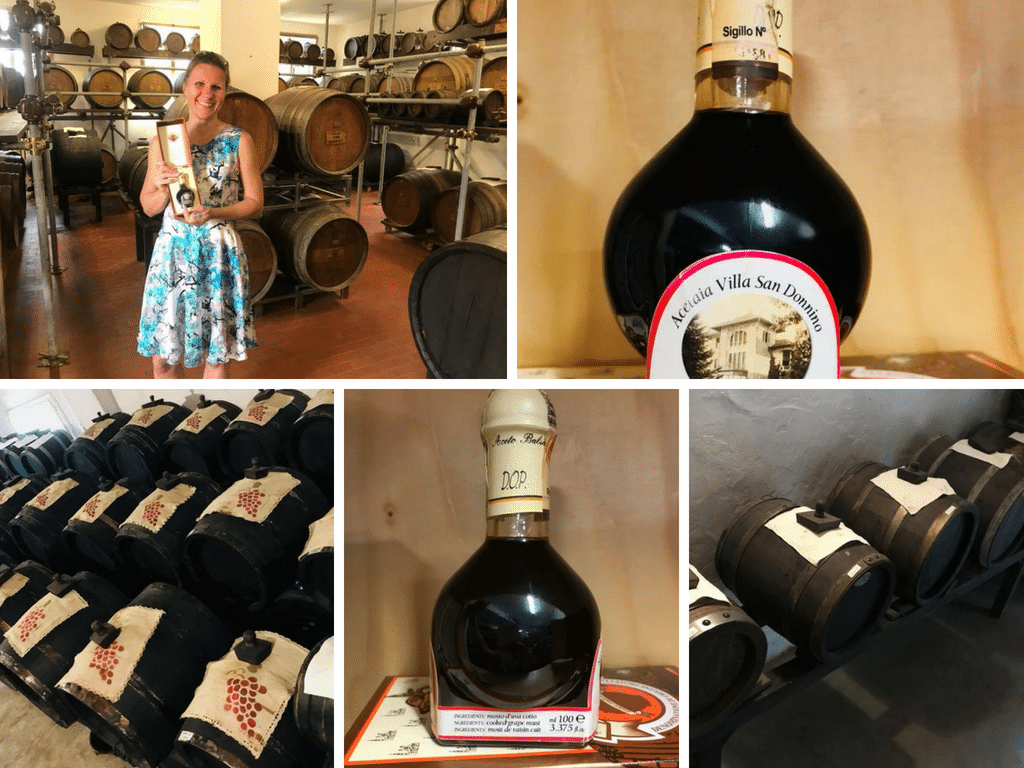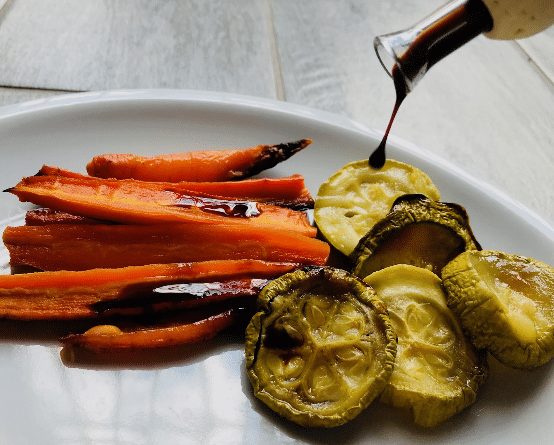I am traveling through Italy this summer. I’m making my way from Milan to Sicily – and have a week to do so. My plan is to stop and explore a few places along the way, destinations that will inspire, educate and enchant.
First stop after Milan: Modena. Located in the Province of Modena in the Emilia-Romagna region of northern Italy, the city has a long history and an insanely rich tradition of food making: Parma ham, balsamic vinegar, and Parmigiano Reggiano cheese are just a few. The best restaurant in the world, Osteria Francescana, is also located in Modena.
In this post, I want to share with you what I had learned about the true, traditional balsamic vinegar. Chances are that you, same as me, have never tried the real deal.
I thought I knew balsamic vinegar. I thought I was buying the best ones. Not so. Here is why.
The tasting experience
When tasting, it became clear that I have never tried the true traditional Modena Balsamic Vinegar. Compared to the commercial types, it’s smooth ( not sharp), highly complex in flavors (more on that below), black in color, and thick. My favorite (12-year bottle) tasted deeply oaky just like a good, full-bodied, well-aged red wine.
We started our sampling experience with the typical off-the-shelf balsamic vinegar you find in a regular health store. It was rough. Acidic. Cutting. Suffocating. It burned my stomach.
We then moved to a 6-year product they are not allowed to call “balsamic vinegar” but it uses the same method as the true balsamic vinegar (more on that below) – the fermentation time is just 6 years instead of the minimum 12. OK, that was already a huge improvement from the commercial one – it tasted much smoother and more refined. None of the suffocating feeling in the nose.
We then entered the “true zone” – the 12-year true balsamic vinegar. I was in awe of the explosion of flavors in my mouth – oak and cherry lingered for minutes afterward. It was only slightly acidic, had a texture of molasses with just the right level of sweetness. It was smooth and silky, with none of the cutting, edgy characteristics of the supermarket products.
The making and contents of a true balsamic vinegar
- A true traditional Modena Balsamic Vinegar does NOT contain any vinegar or added sugar. Its acidic taste comes from years of fermentation. The thickening happens as water and alcohol evaporate over the years (the barrels are left open for years).
- A true traditional Modena Balsamic Vinegar must contain ONLY cooked grape juice – see the product “Ingredients” photo. Nothing is ever added to it. This is unlike other balsamic vinegar that contains added ingredients such as caramel, vinegar, sulfites, thickeners, and preservatives.
- It’s a highly regulated product only produced in Modena and the nearby Reggio Emilia. The DOP consortium certifies and bottles the product. A true balsamic vinegar MUST have the DOP seal (see photos).
- The minimum fermentation process is 12 years and the product value goes up with longer fermentation.
- The barrels where the vinegar ages are only made from local wood – oak, acacia, cherry, juniper, and chestnut. The vinegar is poured every year from a large to a smaller barrel (the volume decreases with the evaporation of water and alcohol) – and ends in a small cask (see photos).
- Each vinegar ends up with its own distinct flavor depending on what wood the cask was made from. For example, during the tasting, I loved the 12-year product much more than the 25-year one but since it’s not a guarantee that it’s consistent, I ended up buying both of them.
- The word “balsam” originates from its past use as a “curative” and “restorative” substance – used for sore throats and digestive troubles.
- A true balsamic vinegar is ONLY bottled in a 100ml half-dome shaped bottle (see photo) and must have the DOP seal.
- There are many products sold online claiming to be DOP-certified balsamic vinegar but their bottles are not in the traditional 100ml dome bottles – don’t buy these if you want the real thing.
- Glaze balsamic vinegar is total BS (I thought that was the real deal) as it contains thickeners and has a sharp and acidic taste.
How to Store and Use It
- True balsamic vinegar never goes bad or moldy and does not have to be refrigerated.
- It goes well as a condiment on top of finished meats, fish, seafood, parmesan, goat cheese, risotto, fruit, chocolate and ice cream. It should NOT be cooked. A small amount goes a long way – less is better as it can overwhelm the meal. It’s too thick for a salad dressing.
- Taking a couple of drops in-between meals is a great way to clear the pallet or it can act as a post-meal digestive.
I’m the proud owner of 2 bottles of this aged vinegar – not for long, I suspect.
If you plan to visit this part of Italy, here is the place I visited. Sadly, they don’t sell their products online 🙁
But, there are options to get it on Amazon (with Prime):
12-year true Modena Balsamic Vinegar, DOP certified
25-year true Modena Balsamic Vinegar, DOP certified
It’s liquid gold, so yes, it is expensive – as any food that has been cared for 12 to 25 years should be.
Also, this is a condiment that should be added sparingly, a few drops at a time go a long way.
And, honestly, there isn’t all that much difference between the 12-year and the 25-year, so if you don’t want to splurge excessively, get the 12-year bottle.
If you have foodie friends, this also makes a wonderful gift.
My favorite way to add the true balsamic vinegar has been on top of roasted vegetables.
I’m utterly impressed with the love, commitment, patience and respect for traditions the Italians commit to making food that enriches every home.
Touring the facility, I kept thinking that if this was in the US, the manufacturer would be thinking of chemical ways to speed up the fermentation process, finding ways to infuse it with the wood flavors (and quickly, too) and making the facility 10 times larger. Not here. Italy is where slow is good.
I hope you have found this post educational and inspirational, and will try adding something new to your diet.


Thanks you again for your inspiring and enthusiastic reports !
Clara
Thank you, Magdalena! You always seem to share exactly what I’m looking for. Enjoy the rest of your fabulous trip:)
-Nichol
Thank you so much Magdalena!
I am Italian American 3rd gen and spent a month in Italy traversing from North to South in 2016 but I missed my Grandmother’s home in Sicily. I can’t wait to go back now with all this beautiful knowleddge! I wish I knew about the best restaurant in the world ( although myfamily’s Restaraunt in Arnara called Ottagano was the best I have EVER eaten at! All food grown right there even the animals!
And I love that you got a personal shopper! I will try that next time! Thank you for seeing appreciating and sharing Italy’s untold Beauty! ❤️Grazie Mille!
Oh and I LOVE Jovial! As a Hashi person I cannot live wo their products! Although I ate wheat in Italy and had ZERO problems interestingly enough…
Because the wheat grown in Europe is not the GMO wheat grown in north America. Monsanto (now Bayer) has been blocked from selling their GMO seed, so far. Italy is very organic as are most of the European countries.
Thank you Magdalena. Your information is very valuable. Enjoy your trip and get a lot of rest.
Thank you for this information. I never liked balsamic vinegar, probably cos it wasn’t the real thing!!!???…. Now I have the chance to try the real thing, many thanks.
Thanks for sharing your trip and what you learned!
Very interesting. Thank you for sharing. Looking forward to more on your trip.
Great read. I really like balsamic vinegar and I haven’t even tried the real deal yet! Definitely going to check that out on Amazon. Enjoyed reading about your trip too. I SO wish I was there. Enjoy the rest of your trip.
So if the ones you buy in an Italian store here in North America are not the real thing, then where do they come from? How can they be labelled as balsamic vinegar of Modena if they do not actually meet the DOP standard? And why is it called vinegar if there is actually no vinegar in it?
Further to post above, this is all so intriguing to me, that Italy maintains their DOP standards with foods like Parmigiano Reggiano and Grana Padano, amongst many other foods. I completely agree with you about the quality of the foods and traditional preparation being important. I strive to do that in my own cooking, and to use real food as much as possible.
Thank you for sharing your journey
What a Joy to read !!
Awesome article. Who knew. Thank you for the Great info. I have never commented on a blog, but loved this one and just had to take the time to let you know I loved it.
I also have never commented, but I just am thankful for this article, as I am with a lot of yours.
In the “How to Store and Use It” section, you used the phrase “clear the pallet.”. The correct term is “cleanse the palate.”. Just thought you’d like to know.
Thank you for writing such an interesting piece about a magnificent food.
Very interesting article on balsamic vinegar…..’who knew and wow on those prices for the real deal.
Thank you for sharing. Very interesting article on balsamic vinegar.
Enjoy your vacation/exploration.
Magdalena dear your trip is so refreshing to me seems you are having a great time thank you for all the good things you are sharing with your clients love learning!!!keep it up and enjoy the rest of your trip
I love this!! Thank you for sharing
[…] vinegar dressing […]